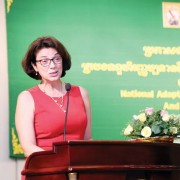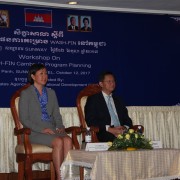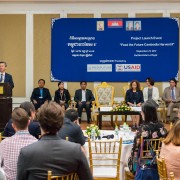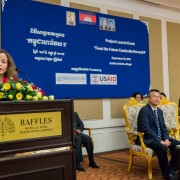Speeches Shim

The Plan is fundamental to ensuring Cambodia is ready to access and effectively use climate financing. The Framework and Plan will help Cambodia address climate risks in critical sectors like agriculture, health, and water. They provide a much-needed road map for targeting resources towards the most important adaptation priorities in those sectors. The process of creating the Framework and Plan has strengthened the capacity of key institutions in Cambodia to address these issues.
The U.S. Agency for International Development (USAID) announced a new, three-year, US$ 3 million initiative that will help close financing gaps that fund universal water supply and sanitation services in Cambodia, today. The “Water, Sanitation and Hygiene Finance” (WASH-FIN) activity will help the private sector make piped water available to those in need.

On behalf of the U.S. Embassy and USAID Cambodia, I am pleased to be here to launch this Program Planning Workshop for the USAID WASH-FIN activity in Cambodia. WASH-FIN – or Water, Sanitation and Hygiene Finance – is a five-year global activity funded by USAID and implemented by Tetra Tech. In Cambodia, WASH-FIN will assist water and sanitation providers to access money to close the financing gaps in expanding piped water supply. We will work closely with WASH-FIN’s in-country team and core collaborators, including the Cambodian Water Supply Association, or CWA, to guide them towards the best private water providers.

His Excellency Ty Sokun, the Secretary of State of the Ministry of Agriculture Forestry and Fisheries, and USAID Cambodia Mission Director Polly Dunford launched “Feed the Future Cambodia Harvest II” today, a project that aims to accelerate the growth of Cambodia’s commercial horticulture in the provinces of Pursat, Battambang, Siem Reap, and Kampong Thom. The project is funded by the U.S. government’s Feed the Future Initiative through the U.S. Agency for International Development (USAID).

The new Feed the Future Cambodia Harvest II program will aim to accelerate growth in the commercial horticulture sector. We are focusing on this sector because Cambodia produces only one-third of the vegetables that its people consume at this time. The rest of the vegetables come from neighboring countries. Given that the agriculture industry employs over 70 percent of the population, we believe that Cambodia could be producing more healthy and nutritious vegetables to better feed its citizens. That is why we are working with the Cambodian government, businesses, universities here and abroad, and farmers to ensure that Cambodian agriculture can feed the Cambodia people.


Comment
Make a general inquiry or suggest an improvement.